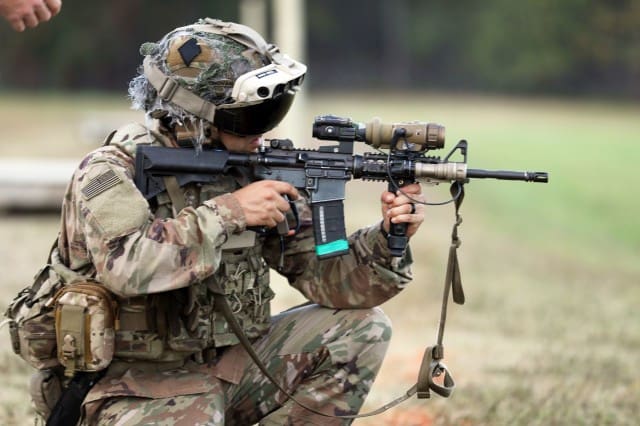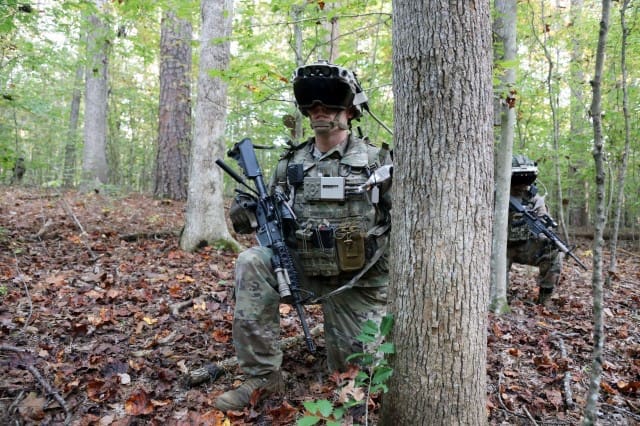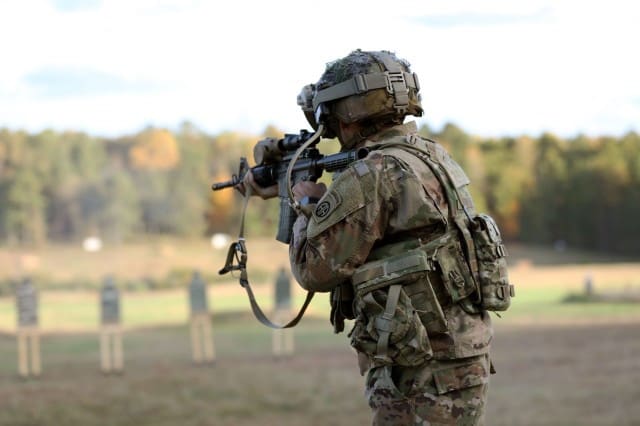
FORT PICKETT, Va. – The third Capability Set of the Integrated Visual Augmentation System (IVAS) was tested at Fort Pickett by 82nd Airborne Soldiers and 25th Marines during October 2020.
The project uses Soldier Centered Design (SCD) to evaluate the IVAS military fighting goggle through operational evaluations. Soldier involvement and engagement at every stage of prototype development has allowed the fast-paced rapid prototype effort to ensure that the final product will positively increase the situational awareness, lethality, mobility, and performance of the close combat force.
“When I look through the IVAS I see how we’re going to fight on the battlefield of the future,” said Staff Sgt. Kester, Weapons Squad Leader.
The Army is developing IVAS as a single platform that allows the Warfighter to Fight, Rehearse, and Train. It integrates next generation 24/7 situational awareness tools and high-resolution simulations to deliver a single platform that improves Soldier sensing, decision making, target acquisition, and target engagement. The visibility that it gives to higher command and control is unparalleled.
“With IVAS you now have the ability to paint a picture for higher ups, almost instantaneously,” said Sgt. Black, Combat Medic. “So now you have a Colonel who’s watching the battlefield like never before. That’s phenomenal, and that has the potential to increase our lethality in a way that we’ve never seen.”
IVAS also provides increased situational awareness for the leadership on the ground.
“In the field, a big part of my job is command and control,” said 1st Lt. Christopher, Platoon Leader. “I am basically moving my squads like pieces on a chessboard and maneuvering them into position and making sure that they’re in the right place at the right time. For me not only can I see where they are with IVAS, but I can actually go into the system and put a point here and say ‘Hey, you all need to go here’ or ‘Hey there are enemies over here watch out!’ I can also send messages non-verbally, so it is very, very critical for me for the command and control aspect.”

The first IVAS militarized form factor prototype was put through tactical exercise lanes, advance marksmanship, land navigation and squad reconnaissance, movement to contact with hasty attack, and enter and clear a trench to validate the military utility that the technology brings to the squad both day and night. The Soldiers and Marines spent a week learning the new equipment before using it in the various operational tests.
“It was extremely easy to pick up,” said Christopher. “It’s very simple in its controls, the menus and such are very easy to navigate, and they’re categorized in a way that if I want to do this function, easy over there, bring up the map, one button press away.”
Christopher also noted that the Microsoft data collectors had been receptive to their feedback and had already made progress and developments on the input given throughout the touchpoint event. Cpl. Sweckard, Team Leader, 25th Marines also expressed similar sentiments.
“Anytime we conduct any type of training with the IVAS, we immediately make contact with the [data collectors] from Microsoft and provide them with feedback, things that we’ve identified that could be an issue, things that we liked, and how we fixed the issue if we were faced with one,” he said. “That way they can put together the common things that are happening with the device and identify a resolution.”
Because of the similarities in operational responsibilities and as members of the collective close combat force, Marines were present to test the current IVAS capability set specifically during live fire execution.
“What it does for us mainly is combines a lot of things that we currently utilize, such as global positioning devices, or GPS’s, communication devices, as well as land navigation tools and mission planning tools,” said Sweckard. “Those are things that are commonly individual technologies that are now combined into this one system of IVAS.”
The project was initiated in response to an erosion in close combat capability relative to pacing threats identified in the 2018 National Defense Strategy. These capabilities will provide the increased lethality, mobility, and situational awareness necessary to achieve overmatch against our current and future adversaries in any domain.

“I think if it’s in the right hands it can be an effective tool, like an aid bag. An aid bag without a medic is nothing, but an infantry guy with IVAS is something much more,” said Black.
Though the Army is specifically developing this high priority modernization effort, the Marine Corps may also leverage the technology for their close combat operations.
“It will definitely be a force multiplier on the battlefield,” said Sweckard. “As a team leader I have three Marines that are under my charge and my basic mission is to employ those Marines in combat, make those three Marines look like 30. If I can do that, that’s going to make the Marine Corps more lethal. With the IVAS I can better achieve that mission, without a doubt.”
The integrated system is expected to be fielded to Soldiers next year.
“When Lieutenant Colonel Winn told us we want to field it next year I thought that was crazy. Then I looked and thought through it and I could see it, I can see the possibilities,” said Kester. “Some of my combat experiences made me pause for thought to look at it like Russia and China, they’ve been pushing technology like this for the last decade. And what have we been doing? Not that.”
Kester added that though he did not know about IVAS before coming to the third Soldier Touchpoint, as soon as he did, he was onboard with Team IVAS.
“I would say the only thing that’s going to hurt this program is people not being imaginative enough or trying to push the limits of what they think is possible, or what Soldiers want. I am really excited to see where this will go,” said Kester.


I can see a lot of hurt feelings and hand-smacked upper echelon when this gets fielded. Yes, it is good for the Colonel to be able to see what’s going on, but the temptation for the Colonel to be telling fire teams what to do, bypassing the chain of command, is going to be a tough one to resist. Once they work the bugs out, there can be some real butt-kicking that goes on.
We don’t need this. It’s added weight, complexity, and logistics. There are hundreds of lethality shortcomings in the army right now that can be fixed using the money wasted on this. If they want to bring the army into the 21st century they need to authorize plate carriers with an authorized products list, get off the soldiers for wearing combat uniforms (that decrease risk of heat injuries, increase comfort, and actually have features that are useful), and provide dual tube NODs and variable optics to ALL of the combat arms units.
Hell, I’d be happier if we could get IOs and legitimate medical supplies in our battalion that we’ve been requesting since 2017.
Ok, here’s how to procure commercial off the shelf (COTS) products you mentioned:
https://www.dla.mil/TroopSupport/ConstructionandEquipment/Spec-Ops-marine-lifesaving/SOE-Ordering-Process/
Right hand side of SSD has the following DLA vendor’s links: ADS, Darley, TSSi, Quantico Tactical, Federal Resources and Unifire. Have their local rep come in and teach your unit how to procure for itself.
Most TOC tents and ECUs were bought through this procurement vehicle. When you see items outside of Program of Record issued products, those are COTS items. Example – Patagonia uniforms are Program of Record issued items to certain USASOC units, Crye Precision uniforms are COTS items procured separately by the unit. Know the difference.
Most units have a budget officer at the Bde and higher level – S8, G8, RMO, Comptroller, Devil $, etc. That person knows how to issue a MIPR to your S/G/J4. Every Bn/Sqn S4 and above should get a TLSP account set up and transfer it to the next S4 everytime they change out.
Most command teams, XOs and logisticians only know what they know….most do not know how to procure COTS products. Even though your commander came from x Special Ops unit doesn’t mean he knows. There are plenty of former ‘Group, Regiment, SMU, etc’ commanders who don’t lift a finger improving their conventional unit they command because they were along for the ride at said former unit, as a group of civilians and small cadre of green-suiters were the ones engaging the DLA prime vendors behind the scenes making it happen for the command. They never taught anyone what they were doing, just making it happen. Ask a Bn S4 in an SF Group how to procure a Sub-T training facility through SOE tents at DLA and they’ll make up something, it won’t be close to anything in the link above. I know SGMs in Corps level G4 positions who swear they were making it happen ‘Back in Group’ but can’t show the division S4’s how to procure Peltor headsets that their commands are requesting how to do it like SOF did! It’s easy, get a Peltor ComTac quote from ADS, Darley, etc., get a MIPR approved for the quote. S4 sends the DLA order form into DLA, DLA asks the S8 for the MIPR and it’s awarded to one of the Primes – vendor makes the order and ships to the unit SSA. Easy.
Most of the products on SSD can be procured through DLA. Some of the Prime Vendors are good at ‘kitting’ up items under one part number, like breaching kits, dive kits, airfield damage repair kits, SOMEDD deployment kits, Sub-T kits, Urban Operations kits, Human Performance/ACFT shelter kits, etc.
COTS items do not have NSNs, nor do you want them to. NSNs take forever to arrive, as the NSN process was created for WWII, etc. Today’s problems need solving now, technology changes, and COTS costs less than NSNs sitting on a shelf at a depot.
Don’t take no for an answer, revise your quad chart and spell out what the $ will help increase. Everybody is told no, but the units who get the money is because some adult thinking was applied to telling ‘why’ it’s needed = they get the money.
No unit has a bank account with $ sitting in it. Everybody must ask, so be the unit that asks. Don’t take no for an answer.
Know the difference between The MICC (post contracting), DLA, GSA, Open Market and S2P2 out of Ft. Drum. They all have their purposes, but if you want a specific product use DLA.
If you’re paying for services, use the MICC and or Open Market contracting (because you don’t care who comes to fix X), use GSA for the credit card purchase at the post SSSC, etc.
All of the ‘contracts’ aren’t user friendly and does not guaranty you receiving The product/manufacturer….a civilian makes the choice on behalf of the Army and not your unit.
Use DLA, they made it on behalf of your unit, you control the process and you get exactly what you order. Kind of simple, but Army folks mess it up daily as they overthink it blending MICC rules to everything….why….because they don’t know.
In closing, use DLA’s TLSP to get the COTS items you need to solve operational problems. Anything else is a waste of your time and efforts or you’re going to end up paying twice to get what you need.
As we’ve said in the industry, Army gonna Army. Now you know, spread the word.
Plate Carriers, Ops-Core helmets, are already Program of Record through Big Army so it’s tough for your command to buy those, which is why you see SOF units wearing their Crye Plate Carriers vs JPCs. The plate carrier is issued and they can’t get around the PoR.
If you can find one of these that were issued, the Soldiers that have them love them: https://soldiersystems.net/tag/kdh/
Well put
SSD, just trying to help those who want to help their command’s!